Upcoming Intel Based Motherboards from GIGABYTE, ASUS, MSI and ASRock
by Ian Cutress on April 28, 2014 3:30 AM ESTASUS’ New Products
The ASUS set of images came about via a leak at an APAC event. Apparently one media representative invited to that event (and should have been under NDA) took pictures and then distributed them via Weibo in spite of the NDA. At this present time ASUS has not officially released any other pictures of its range, so we are left to decipher these blurry photographs.
The whole range seems to have removed the mustard color and gone for a more subtle dull metallic gold. The iconography is around the livery and a chipset heatsink with a circular image.
First up is the mini-ITX model:
Here ASUS have put the 24-pin ATX power connector outside the DRAM slots and the CPU power connector is in an easy to reach place on the top. The socket area is more central, meaning the chipset is squashed down towards the PCIe slot. The SATA ports are spread out such that two are near the 24-pin ATX (along with a USB 3.0 header) and two are inside the DRAM slots at the bottom.
On the high end of the market is the Deluxe:
The styling is easier to see here, especially with the power delivery heatsink reaching around three sides of the CPU socket. On the right there are some SATA Express ports, with an M.2 just between the chipset heatsink and what looks like the TPU switch. As the Deluxe is high up the scale of the board list, we see two USB 3.0 headers near the 24-pin ATX connector as well as an 802.11ac WiFi module on the rear IO. It looks like the audio also has had an update, and we move to Dual Intelligent Processors V (five).
The workstation model was also on display:
Despite the small grainy picture, we see four PCIe slots and a heatsink exactly where a PLX8747 would be, suggesting an x8/x8/x8/x8 PCIe layout for four-way SLI. It is perhaps interesting that we see this on the WS and not on the Deluxe. Like the Deluxe we have dual USB 3.0 headers, SATA Express ports and an M.2 slot. There are dual two-digit debugs at the bottom for enhanced error reporting, and the chipset heatsink is larger than the others, perhaps to accommodate a controller or two.
There is also an image of three ROG motherboards being released, including the Hero, Gene, and the Ranger which is new to the brand.
TUF gets some love as well with the Sabertooth:


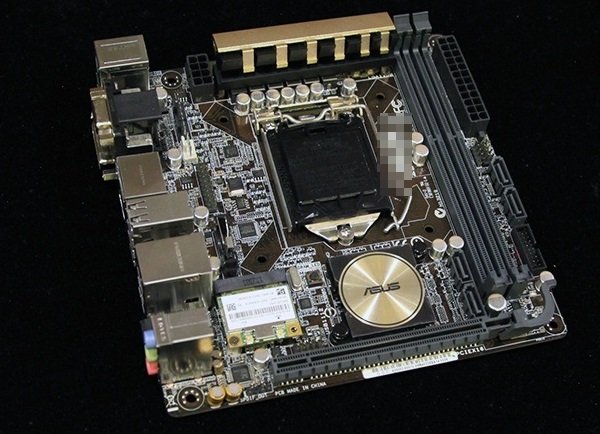
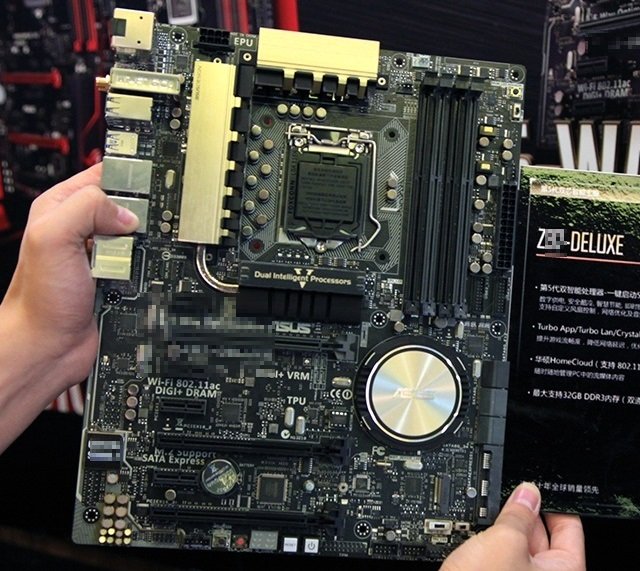
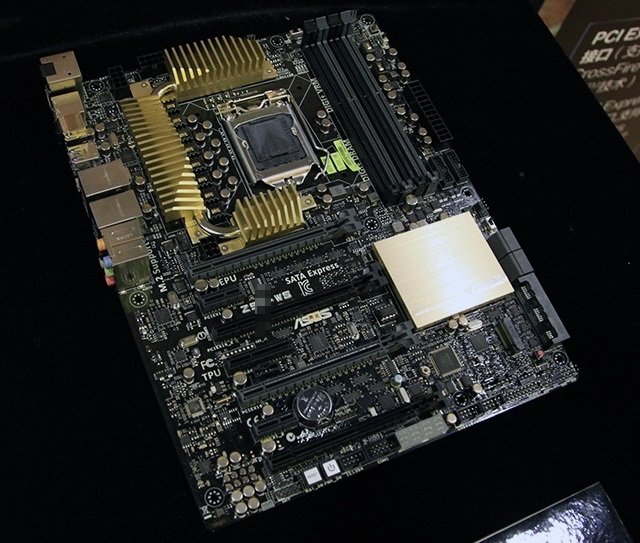
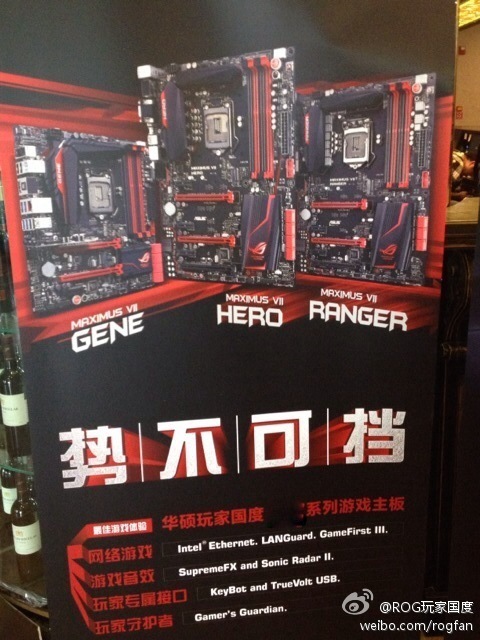
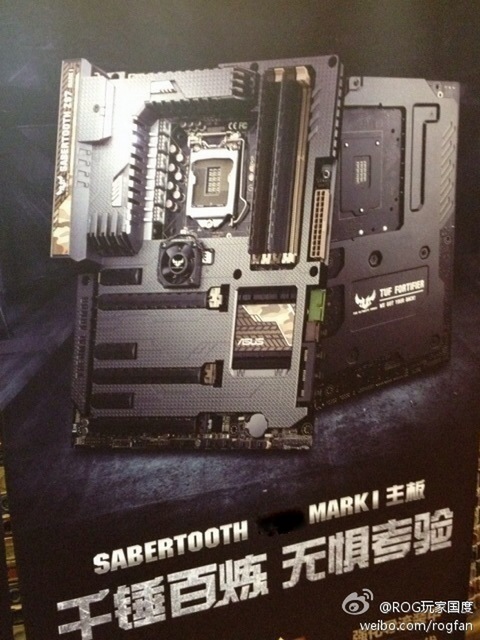








58 Comments
View All Comments
Devo2007 - Monday, April 28, 2014 - link
I know at least one enthusiast site already posted a review of a Z97 board today; a site that, AFAIK has usually adhered to NDAs.Devo2007 - Monday, April 28, 2014 - link
.. Actually, one of the boards shown here (and with non-blurry photos to boot).That said, if the NDA is still in place, kudos to Anandtech for not breaking them. You guys don't need to be "first" to post reviews and such as the quality of content makes any wait worth it.
Flunk - Monday, April 28, 2014 - link
I wholeheartedly agree there, best is much better than first and Anandtech is one of the only top-tier tech sites in my eyes.Antronman - Monday, April 28, 2014 - link
As per the usual, Asus will leave the competition in the dust and be the only choice for a serious build.jimjamjamie - Monday, April 28, 2014 - link
Are they really that much better than say Gigabyte? What makes them better? Genuinely interested as I'm using a G1.Sniper just now and I don't think I have any complaints.willis936 - Monday, April 28, 2014 - link
Their marketing is clearly better. The only reason I went asus on my last build is because the number of fan headers and bios fan voltage control was better than what I found on other boards of the same price. In most cases you'll get what you pay for and just make sure the boxes you want checked are checked (decent audio codec, PCIe requirements, outward facing port requirements, etc.) In the gaming/overclocking market there isn't much variation between products in terms of meaningful stability/overclocking features. The power circuitry has become much less important in recent years because they're all much better than they used to be. The biggest factor is the silicon lottery with your CPU/GPU nowadays.Antronman - Monday, April 28, 2014 - link
Power circuitry still does matter.A couple hundred MHz can mean the difference between a world record or "getting close".
Higher rated caps and VRMs, means more stable and better power delivery.
Fuse protections means any sudden jump in voltage or power problem means that your product won't be reduced to a piece of silicon with a bit of metal.
LN2 mode buttons means more precise OCing for new OCers.
Super stable BIOS.
That's not just the boards, but the GPUs as well.
All that's missing is a good chip.
willis936 - Monday, April 28, 2014 - link
Certainly but people looking to drop a few grand on LN2 aren't people looking to make a stable daily build. If you want more performance on a computer you'll be booting and running daily the chip variation matters a lot more than component quality. I just have a hard time trusting anything I can safely say is more marketing than engineering. A good daily OC will see little difference between a $150 board and a $400 board. What really changes is the storage and peripheral interface features.Antronman - Monday, April 28, 2014 - link
But it will.Less voltage means it is a better OC.
With RoG, you can consistently use less voltage to OC your chip.
RoG has a superior interface, and also way more WC support.
Just about every major watercooling product maker (e.g. EKWB, XSPC, Aquacomputer) has mobo blocks for almost every RoG board.
willis936 - Monday, April 28, 2014 - link
You'll only be using less voltage on better chips.